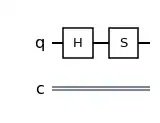It helps to know the action of various gates on the computational basis states. For example, the S gate
$$
S = \begin{pmatrix}
1 & 0 \\
0 & i
\end{pmatrix}
$$
keeps $|0\rangle$ fixed while phasing $|1\rangle$ by $i$. This means that if we had the state $|0\rangle+|1\rangle$ then $S(|0\rangle+|1\rangle)$ is $|0\rangle+ i|1\rangle$, i.e. the state we need. We can obtain $|0\rangle+|1\rangle$ by applying Hadamard
$$
H = \frac{1}{\sqrt{2}}\begin{pmatrix}
1 & 1 \\
1 & -1
\end{pmatrix}
$$
to the $|0\rangle$ state.
In summary, you can apply Hadamard and the S gate to the $|0\rangle$ state
$$
SH|0\rangle = S\frac{1}{\sqrt{2}}(|0\rangle + |1\rangle) = \frac{1}{\sqrt{2}}(S|0\rangle + S|1\rangle) = \frac{1}{\sqrt{2}}(|0\rangle + i|1\rangle)\tag1
$$
where we included normalization factors.
Note that $(1)$ is not the only way to obtain $|0\rangle + i|1\rangle$. For example, the $\frac{\pi}{2}$ Y rotation
$$
R_y\left(\frac{\pi}{2}\right) = \frac{1}{\sqrt{2}}\begin{pmatrix}
1 & -1 \\
1 & 1
\end{pmatrix}
$$
can be used in place of the Hadamard. This is useful on hardware platforms that may not implement Hadamard natively.

